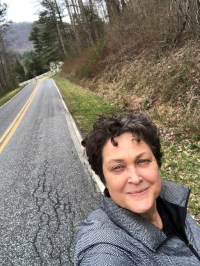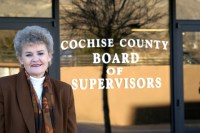On March 11, 2021, the Biden administration enacted the American Rescue Plan (ARP) to ease pandemic-related financial hardship for families and communities across the country. The ARP extended emergency relief, drastically cut unemployment and child poverty rates, and delivered millions of dollars to local governments to address unique needs in their communities. On the ARP’s second anniversary, Americans across the country share how this historic funding has helped them and their communities.
Michele Grim

Michele Grim pictured in November 2022. (Photo credit: Michele Grim)
Ohio
With a background in public health, Michele Grim saw the need for people like her to run for elected office during the pandemic. Upon being elected to the Toledo City Council, Michele looked to funds from the American Rescue Plan to implement a solution to her community’s growing medical debt. After partnering with Lucas County and the nonprofit RIP Medical Debt, both the city of Toledo and the state of Ohio dedicated a combined total of $1.6 million in ARP funding to purchase $190 million to $240 million in community medical debt. This will relieve debt burdens for around 41,000 Ohioans. Since the plan’s announcement, dozens of local governments have reached out to Michele with an interest in replicating the Toledo model in communities across the country.
Click here to see more from Michele.
Isreal Mosley

Isreal Mosley pictured in July 2020. (Photo credit: Erin Towns)
Maine
Isreal Mosley is a single father to two sons and works for a nonprofit that advocates for public policies to support working families and their children. Isreal’s advocacy is driven by his own experiences trying to make ends meet while raising a family; over the course of the pandemic, rent skyrocketed in Isreal’s community of Waterville, Maine, straining the $1,900 in income that he brings home each month. When Isreal received the American Rescue Plan’s monthly child tax credit, it helped him afford rent and other necessary expenses, in addition to new school expenses, including clothes, for his boys. Across the country, the monthly CTC helped families such as Isreal’s make ends meet and provide necessities for their children. While the expanded CTC expired after December 2021, Isreal hopes that Congress can revisit the policy that greatly helped his family.
Click here to see more from Isreal.
Sally Weldon

Sally Weldon pictured in October 2021. (Photo credit: Sally Weldon)
North Carolina
Almost 20 years ago, Sally Weldon followed her heart and moved to Weaverville, North Carolina, to be with her husband. She instantly fell in love with the house her husband built nestled in the picturesque landscape of the Blue Ridge Mountains. Living in rural North Carolina is perfect for Sally, except for the lack of reliable and affordable high-speed internet. When she had to work from home during the pandemic, the slow, spotty internet connection became an increasingly bothersome issue. Only one person at a time could use the internet in her home, so when her granddaughter visited and needed to attend virtual school, Sally and her husband couldn’t work on their computer. But these internet troubles may soon be resolved thanks to investment to expand broadband under the American Rescue Plan. With $6 million in funds allocated to Sally’s rural county, projects to extend high-speed, reliable broadband to rural residents are already underway.
Click here to see more from Sally.
Stormy Johnson

Stormy Johnson pictured in January 2023. (Photo credit: Stormy Johnson)
West Virginia
A single mother to three children, Stormy Johnson lives paycheck to paycheck as a student support specialist for the schools in Preston County, West Virginia. After paying her family’s monthly bills, she sometimes has just $50 left over for food and other necessities—and over the years, she has often skipped meals so her kids can eat. When COVID-19 prompted local schools to switch to a virtual learning model in 2020, Stormy found herself traveling more for her job, which strained her old, sometimes unreliable car. So when Stormy received the first payment from the American Rescue Plan’s monthly CTC, she was grateful to have some much-needed relief. The CTC allowed Stormy to afford a down payment on a new vehicle and budget more for groceries so that she wouldn’t have to skip meals. During a pandemic that has posed sudden financial challenges for millions of American households, the CTC provided struggling families such as Stormy’s with more financial security. After the CTC’s expiration in December 2021, Stormy decided to share her story to advocate for a permanent expansion.
Click here to see more from Stormy.
Ann English

Ann English pictured in front of the Cochise County Board of Supervisors office in 2015. (Photo credit: Ann English)
Arizona
Douglas, Arizona, sits along the U.S.-Mexico border. The Douglas Port of Entry is important to the economy of the entire country, as hundreds of millions of dollars in trade flow through it each year. As the county supervisor for the past 20 years, Ann English has seen the Douglas port grow increasingly congested. The congestion causes hourslong wait times, and the transportation of extra-large cargo and hazardous materials poses a health and safety risk to the surrounding communities. To relieve congestion and expand trade, Cochise County, which includes Douglas, hoped for decades to add a second port dedicated to commercial trade. But its small tax base could not fund a project of such scale. The only way to get funding was through investments from the state and federal government—and the American Rescue Plan finally delivered some of the necessary funding. Douglas has begun planning the much-needed project: In combination with investments from the state and the General Services Administration, Cochise County has dedicated $5 million to planning the infrastructure that will support the port. Once completed, the port will bring more economic opportunities to Douglas, while expanding the trade that supports the rest of the country.
Click here to see more from Ann.
Conclusion
The American Rescue Plan was instrumental in creating unprecedented economic recovery in the wake of the COVID-19 pandemic. Two years later, Americans across the nation are still experiencing the benefits of its historic investments.
Thanks to the grant we received from the American Rescue Plan Act to expand our market, construction has started on our new location, which will provide the community with 60 feet of fresh produce options. We’re also expanding the options for customers who rely on WIC [the Special Supplemental Nutrition Program for Women, Infants, and Children], which is a big deal since many in our neighborhood have limited access to things like baby food and baby formula. The folks I talk to in our neighborhood are really excited about the new departments and new food options we’ll be able to offer soon.
The investment in rural infrastructure, in particular, broadband, was a great shot in the arm. We still have a lot of work to do to make the cost of living in rural communities affordable.
Since I received a loan from the American Rescue Plan Act, it has undeniably helped me set up my business properly and start dreaming bigger. I used the loan to create a professional business website with updated contact information. This helped me reach and attract new and potential clients. Now, I can focus on working towards opening a storefront and growing my business even more.